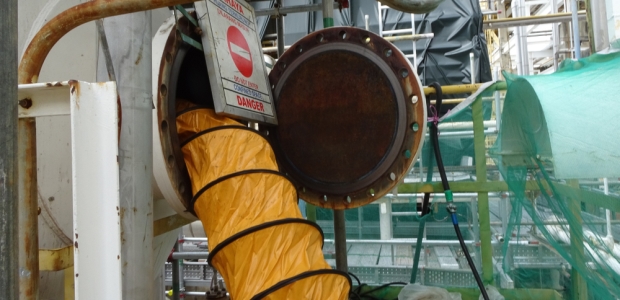
Gas Detection for Safe Confined Space Entry
It's more than a best practice—it is essential to test the air prior to and during entry, as OSHA requires.
- By Jerry Laws
- Dec 01, 2018
Atmospheric hazards are a key consideration when planning any confined space entry. As Chris Koester, owner of Priority One Safe-T, LLC, an emergency response services and rescue training firm for industrial and manufacturing companies, pointed out in his confined space article in our August 2018 issue, NIOSH investigations of 670 confined space fatalities showed that atmospheric hazards were associated with about 56 percent of the deaths. The most common types of gases in confined spaces were hydrogen sulfide and carbon monoxide.
OSHA's confined space standard, 29 CFR 1910.146, requires employers to identify hazards in confined spaces, test the air prior to entry and also during the entry, keep the space ventilated, have on hand proper safety equipment for entry and exit and rescue, and have procedures for summoning proficiently trained rescue teams that can respond in a timely manner.
A confined space:
- Is large enough for an employee to enter fully and perform assigned work,
- Is not designed for continuous occupancy by the employee, and
- Has a limited or restricted means of entry or exit.
Examples include vaults, tanks, storage bins, pits, silos, and similar areas.
A permit-required confined space as defined by OSHA has one or more of these characteristics:
- Contains or has the potential to contain a hazardous atmosphere
- Contains a material with the potential to engulf someone who enters the space
- Has an internal configuration that might cause an entrant to be trapped or asphyxiated by inwardly converging walls or by a floor that slopes downward and tapers to a smaller cross section
- Contains any other recognized serious safety or health hazards
Employers in general industry must evaluate their workplaces to determine whether spaces are permit spaces. If a workplace does contain permit spaces, the employer must inform exposed employees of their existence, location, and the hazards they pose. This can be done by posting danger signs such as "DANGER -- PERMIT-REQUIRED CONFINED SPACE -- AUTHORIZED ENTRANTS ONLY" or using an equally effective means, according to the agency.
If employees are not to enter and work in permit spaces, their employers must take effective measures to prevent them from entering these spaces. If employees are expected to enter permit spaces, the employer must develop a written permit space program and make it available to employees or their representatives.
Atmospheric Testing in Confined Spaces
A recent OSHA enforcement case against an Alabama tank cleaning firm included citations for failing to ensure atmospheric testing and monitoring equipment was properly maintained, allowing employees to enter permit spaces without the proper equipment, and allowing them to enter without preparing an entry permit. Proposed penalties totaled $171,281 in the case, which was announced in October 2018.
One of the citations was for a willful violation, with OSHA inspectors concluding the employer had not done testing for atmospheric hazards at all in a permit space before employees were authorized to enter it.
The OSHA standard directs that, before an employee enters the space, the internal atmosphere shall be tested with a calibrated direct-reading instrument for the following conditions, in the order given: 1) oxygen content, 2) flammable gases and vapors, and 3) potential toxic air contaminants. It also says there may be no hazardous atmosphere within the space whenever any employee is inside the space.
Some of today's single-gas and multi-gas monitors are wirelessly connected; long-life, maintenance-free monitors are available to conduct atmospheric testing prior to entering a confined space and as long as an employee occupies the confined space.
If a hazardous atmosphere is found in the space during entry through use of a monitor, the standard says each employee must leave the space immediately, and then it must be evaluated to determine how the hazardous atmosphere developed, and measures must be implemented to protect employees before any subsequent entry is made.
Then, the employer is to verify the space is safe for entry and that the required pre-entry measures have been taken, through a written certification that contains the date, the location of the space, and the signature of the person providing the certification. The certification must be made before entry and be made available to each employee entering the space or to the employee's authorized representative.
Training Requirements
According to OSHA, before the initial work assignment begins, an employer must provide proper training for all workers who are required to work in permit spaces. When training has been completed, employers must ensure the workers have acquired the understanding, knowledge, and skills necessary to safely perform their duties.
Additional training is required when the job duties change; when a change occurs in the permit space program or the permit space operation presents any new hazard; and when an employee's job performance shows deficiencies. Rescue team members also must be trained in CPR and first aid, and employers must certify that this type of training has been provided.
Records of the employee training are to be kept and made available for inspection by employees and their authorized representatives.
Performing atmospheric testing as required and providing the proper training, equipment, and rescue capability will add up to a successful confined space program. For a full understanding of the OSHA confined space monitoring requirements, visit www.osha.gov and search for the 29 CFR 1910.146 standard.
This article originally appeared in the December 2018 issue of Occupational Health & Safety.